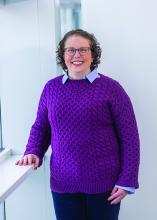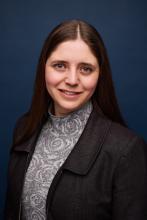Nursing faculty and students leverage advancements in computing and data to move the field forward
By Daniel Robison
As a nurse, Megan Foradori, RN, tried to make sure no child in need of developmental support fell through the cracks.
Across pediatric nursing roles in multiple states, she saw firsthand how babies and toddlers are screened for crucial social, speech and developmental milestones—and fiercely advocated for services for children who scored poorly.
“These services can transform their futures—especially at key periods of brain and physical growth,” said Foradori, a PhD candidate at Case Western Reserve University Frances Payne Bolton School of Nursing. “But I also saw service providers stretched too thin and doctors hesitating to deliver potentially distressing news to parents—instead hoping the child might outgrow the issue.”
The experiences inspired Foradori to focus her PhD thesis to better identify patterns on which children are screened and receive services—and determine who is being missed along the way. She is using machine learning algorithms—a form of artificial intelligence (AI)—to analyze large datasets, including the National Survey of Children’s Health from the U.S. Health Resources and Services Administration.
“Each child in the data has a unique constellation of characteristics,” said Foradori.
“Machine learning helps us drill down and see drivers of outcomes we couldn’t have seen ourselves because of the sheer volume of data and the complexity of each child.”
From her research, Foradori is aiming to create new clinical guidance to help more children receive key interventions—such as speech and behavioral therapy—before entering kindergarten, which research shows can significantly improve their long-term development.
“My personal experiences as a nurse showed me the realities of how kids can get left behind,” she said. “Now as a researcher, I can pair my nursing background with deep data analysis to find ways to help children when they need it the most.”
On the cusp
Like Foradori, several faculty members and graduate students at the nursing school are using AI-related approaches in research, practice and education.
Their applications of the technology have the potential to improve many aspects of healthcare—accelerating scientific discovery, helping physicians and nurses make better decisions, improving medical advice for patients and reducing the burden of paperwork.
“These are not necessarily new research methods or forms of statistical analysis,” said Andrew Reimer, PhD, RN (NUR ’04; GRS ’10, nursing), associate professor of nursing. “But now we have the computing ability to handle larger datasets and come to deeper levels of comprehension.”
In recent years, Case Western Reserve has created a high-performance computing cluster—available to researchers across the university—that allows for computationally intensive research using advanced servers, processors and software systems. This formidable resource enables faculty to tackle large-scale, data-intensive problems and run complex simulations and analyses more efficiently and accurately than before.
“It’s a powerful system allowing us to examine every possible combination of variables, leading to more thorough understanding of research questions—and helping us arrive at more accurate results,” said Ron Hickman Jr., PhD, RN (CWR ’00; NUR ’02, ’06, ’13; GRS ’08, nursing), associate dean for research at the nursing school.
The university’s computing cluster has accelerated AI-related activity at the nursing school, leading to an array of projects that highlight both the immense opportunities and the challenges of integrating AI into healthcare discovery and practice.
“Our research is right there on the cusp of realizing what’s possible using AI to improve health,” said Hickman.
Rural health realities
Imagine someone in rural Ohio suffers a heart attack. The response involves multiple steps—calling 911, dispatching local emergency services and transferring the patient to a hospital—and often depends on a helicopter transporting the patient to an urban medical facility.
“Especially when dealing with these critical conditions, every minute counts,” said Reimer. “Still, there are many patients moved by medical transport who don’t benefit at all.”
One in five Americans live in rural areas, which make up nearly 97% of the country’s land. This distribution creates challenges for accessing healthcare services—particularly in emergencies—and helps explain why rural patients have the worst outcomes of any broad geographic group in the top five leading causes of death, including strokes and traumatic injuries.
Reimer is aiming to better predict transport outcomes to determine which patients should be transferred and when. Using machine learning, he’s integrating disparate datasets—electronic health records (EHRs), transport information, social determinants of health and other variables—into a new platform that pinpoints the factors affecting care and so-called “transport deserts,” where access is limited.
For one, data for studying the issue comes from many separate sources and serves different purposes. Each captures an aspect of the continuum of care, such as a patient’s home location, municipality data on their emergency response services and closest medical helicopters.
“By layering data in new ways and fusing them together from a geographic perspective,” said Reimer, “we create a more complete picture of what’s happening—and how we can optimize patient transport decisions, especially when time is of the essence.”
The research is informing Reimer’s efforts to develop a clinical tool to help align the care appropriate for each patient’s condition.
“This can lead to better distribution of the very limited emergency resources that cover vast areas of our country,” he said.
From data to decisions
Vast troves of patient data—including EHRs—could contain undiscovered revelations about the multifaceted nature of human health.
By analyzing EHRs with machine learning methods, nursing school researchers are exploring predictive tools that could improve the guidance providers give to patients.
To Nicholas Schiltz, PhD (GRS ’13, epidemiology and biostatistics), an assistant professor at the nursing school, the possibilities have the potential to transform healthcare.
“There are AI-based models that can predict things or figure out things better than a human,” said Schiltz. “A lot of times they do outperform a clinician in certain areas, especially when there’s complexity and rarity involved.”
Schiltz is studying how projecting likely patient outcomes—including disease trajectories for high-risk subgroups, particularly in older adults—can identify underlying causes and facilitate early intervention strategies.
“Machine learning is helping us understand optimal prevention and treatment strategies in a more nuanced way,” said Schiltz. “When we can identify which health conditions are likely to occur next, given patients’ current characteristics, we can find the right course.”
Schiltz, who also serves as Foradori’s advisor for her work analyzing large datasets to improve developmental support for children, has used machine learning techniques in multiple studies.
In research published in Journal of General Internal Medicine, Schiltz used Medicare claims data to identify combinations of morbidities associated with hospital readmissions. The same information also revealed that limitations in basic activities of daily living—preparing meals or housekeeping, for instance—can be used to better predict risk of re-hospitalization.
“The goal is to eventually integrate related assessments into EHRs so providers can identify at-risk patients during appointments,” he said.
However, moving research to practical applications in healthcare settings can require a significant effort and expense—including testing, validation and ensuring that AI tools are effective across diverse populations.
As it stands, many genomic datasets are composed mostly of white patients with Northern European ancestry, meaning AI models trained on the information can reinforce existing biases. Plus, the resulting tools may not perform effectively for other races or ethnicities.
“Implementation science is an emerging field,” said Schiltz. “It’s not enough to just make evidence—we have to consider how providers will actually use these tools on a daily basis.”
Companion for caregiving
Instead of flipping through textbooks or scouring the internet for reputable information, Chitra Dorai imagined there had to be a better way for dementia caregivers to quickly get answers to their questions.
Dorai knew the experience all too well. While caring for a parent with Parkinson’s disease, she recalled feeling ill-prepared for the challenge. “I was not alone in needing a source of support and information,” she said.
Drawing on her two-plus decades as an IBM executive, Dorai founded Amicus Brain Innovations and created an AI-enhanced text messaging chatbot, named Keiko, to serve as a digital advisor for dementia caregivers.
Trained using large language models, Keiko “interacts in a conversational style in multiple languages and provides personalized guidance based on research,” said Dorai.
Helping dementia caregivers is also a cornerstone of the work of Kylie Meyer, PhD—driven by her personal experiences. During college, she held a family intervention to discuss the dementia symptoms of a close relative, who was later diagnosed with Alzheimer’s disease and primarily cared for by a spouse.
“I got to see caregiving up close and the difficult conversations that come with it—including the costs involved,” said Meyer, an assistant professor at the School of Nursing.
To help reduce the nearly $470 billion annual financial burden on unpaid caregivers, as estimated by the AARP Public Policy Institute, Meyer developed an intervention called CONFIDENCE. This program, featuring online group-based learning sessions and workbook exercises, aimed to offer much-needed support. However, early users suggested that the program could benefit from being more engaging.
Enter: Keiko.
Working together, Meyer and Dorai integrated the AI-powered chatbot into CONFIDENCE. Now, they are in the midst of a clinical trial with Latino caregivers, who spend a disproportionate amount—nearly half (47%) of their household income—on such expenses, compared to 26% among caregivers from other ethnic backgrounds.
“If our intervention works for Latino families, then it’s on the right track for addressing these issues for caregivers in general,” said Meyer.
While the program uses new technology, it’s rooted in the time-tested principle of resourcefulness—an approach that provides caregivers with the flexibility to learn and receive coaching in ways that fit their schedules and preferences.
“Using this tool to help people was a ‘wow moment’ for me,” said Meyer. “The tech is here now—not in some distant future.”
Smart care coordination
It’s long been established that poor care coordination—transitioning patients to the next point of treatment—can lead to negative health outcomes and an increased economic burden on patients and society.
Still, conventional approaches have changed little in response to such evidence—often involving manually sifting through patient files and calling lists of providers to arrange transfers of care.
“Having been a nurse for many years, I’ve seen the inefficiencies,” said Hickman, who is also the Ruth M. Anderson Professor at the nursing school. “Especially given the high caseloads of care coordinators and frustration of patients, changes are needed.”
Recently, Hickman began a collaborative effort with Ashley Barrow, an entrepreneur and former care coordinator. In 2019, she founded the startup RE-Assist and is building an AI-based tool of the same name that aims to digitize and improve care coordination.
Still in development, the cloud-based software service uses algorithms to interrogate many types of EHRs to make care recommendations to hospitals and patients. The aim is to streamline coordination between them, as well as insurance companies and providers.
“It’s not meant to replace care coordinators, but to assist them,” said Hickman.
Together, he and Barrow are refining the algorithms that extract information from EHRs, while conducting simulations with anonymized patient data and gathering feedback in focus groups with patients and healthcare professionals.
It’s a lengthy process of validation that means the tool could be years away from use—but it’s worth the investment of time, Hickman said.
“AI applications like this have great potential to make us better nurses,” he said. “Researchers have a duty to lead by example—and that means using and developing new technology carefully and responsibly.”
This article appears in the print edition of Forefront magazine, summer 2024. Find more stories from Forefront at case.edu/nursing/news-events/forefront-magazine.







